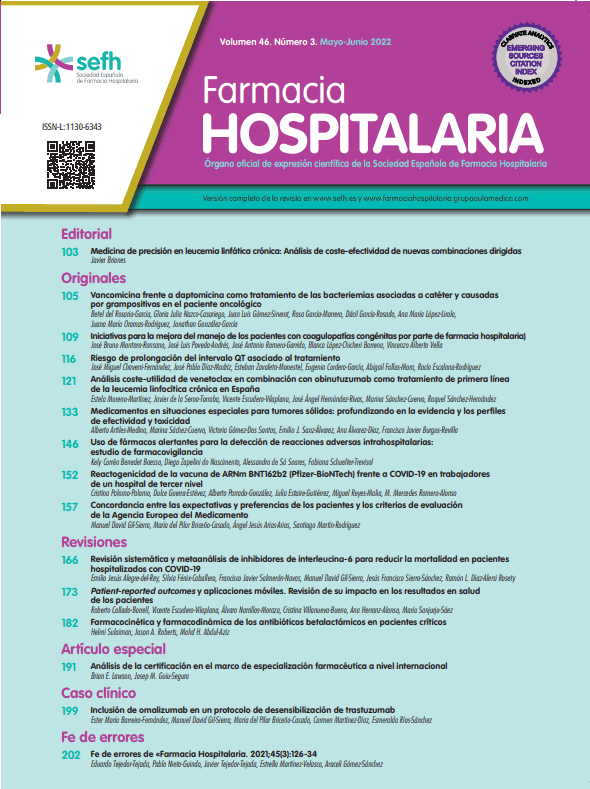Información de la revista
Vol. 27. Núm. 4.
Páginas 219-223 (Julio 2003)
Vol. 27. Núm. 4.
Páginas 219-223 (Julio 2003)
Acceso a texto completo
Detección de errores en la prescripción de quimioterapia
Visitas
3509
Este artículo ha recibido
Información del artículo
Objetivo: Analizar los tipos de errores en la prescripción de citostáticos. Material y métodos: Estudio prospectivo del 1 de febrero al 15 de abril de 2002). Se revisaron todas las órdenes médicas con citostáticos. Se estudiaron 13 variables: identificación, datos antropométricos, diagnóstico, protocolo, número de ciclo, citostáticos, duración de tratamiento, dosificación, vía de administración, volumen de infusión y/o concentración final, tiempo de infusión, diluyente y firma del médico. Para cada variable se distinguieron varias posibilidades de error. También se recogió si era primer ciclo, el servicio prescriptor y el formato de la prescripción. Resultados: Se revisaron 618 órdenes médicas con 1.178 líneas de citostáticos y 2.171 dosis. El número de oportunidades de error fue 12.101 y el número total de errores encontrados 2.706 (22,03%). De éstas no todas tienen igual repercusión para el paciente. Los errores causados por omisión fueron 2.340 (87,77%). Los que dificultan la revisión y/o administración por enfermería fueron 281 (10,54%). Los errores potencialmente graves fueron 60 (2,06%): superficie corporal errónea >10%: 5; SC errónea 5-10%: 2; protocolo erróneo: 2; volumen incorrecto: 16; dosificación errónea: 23 (difiere > 25%: 5; difiere 10- 25%: 14; difiere < 10%: 4); se indica reducción y no hay: 9; diluyente inapropiado: 3. No hubo ningún medicamento omitido ni equivocado. Conclusiones: La descripción de errores y su cuantificación es útil como método de garantía de calidad para establecer las medidas correctoras oportunas. Los errores más frecuentes han sido por omisión de información, por lo que habrá que incidir en ello y en la promoción de la prescripción informatizada.
Palabras clave:
Errores de medicación
Citostáticos
Quimioterapia
Errores de Prescripción
Objective: To analyse errors detected in the prescription of cytostatic drugs. Material and methods: Prospective study (February 1st to April 15th, 2002). All medical orders containing cytostatic agents were checked and 13 variables were studied: identification, anthropometric data, diagnosis, protocol, number of cycles, cytostatic drug, length of treatment, dose, route of administration, volume of infusion and/or final concentration, infusion time, diluent, and doctor's signature. Several possible errors were identified for each variable. Information on whether it was the first cycle, prescribing service, and prescription format was also recorded. Results: In all, 618 medical orders were reviewed for a total of 1178 lines of cytostatic agents and 2,171 doses. The possible number of errors was 12.101 and the total number of errors actually found was 2,706 (22,03%). Not all these errors had the same impact on patients. Errors by omission were 2,340 (87,77%). Those which nursing staff found difficult to check and/or administer stood at 281 (10,54%). Potentially serious errors numbered 60 (2.06%): wrong body area > 10%: 5; wrong body area 5-10%: 2; erroneus protocol: 2; incorrect volume: 16; wrong dosage: 23 (difference > 25%: 5; difference 10-25%: 14; difference <10%: 4). Reductions indicated but not implemented: 9; inappropiate diluent: 3. There were no incorrect or omitted medications. Conclusions: The description of such errors and their quantification is a useful method of quality aasurance in order to establish appropiate corrective measures. The most common error was the omission of information and therefore this issue, along with the development of computerised prescriptions, should be addressed.
Keywords:
Medication errors
Cytostatic drugs
Chemotherapy
Prescription errors
El Texto completo está disponible en PDF






